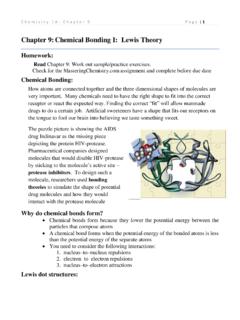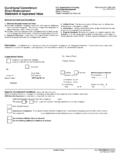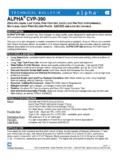Transcription of E l e c t r o c h e m i s t r y C h 1 9 P a g e | 1 ...
1 Electrochemistry Ch 19 Page |1. Electrochemistry Ch. 19 Notes: Homework: Read Chapter 19, Bonus: 39, 41, 43, 45, 47, 51, 55, 61, 63, 65, 67, 71, 73, 77, 81, 87, 89, 91, 99, 109. Check MasteringChemistry Deadlines Electrochemistry: All chemistry is electrical in the sense it involves electrons and other charged ions. The term Electrochemistry is reserved for the study of the processes that convert chemical energy to electrical energy and vice versa. Spontaneous reactions are labeled Voltaic Cells or Galvanic Cells, derived from the names Luigi Galvani (1737-1798) and Alessandro Volta (1745-1827). These cells use spontaneous redox reactions to produce electric current, electrons flow from one terminal (anode) to another (cathode) when connected by an external circuit and a salt bridge.
2 Example cases of spontaneous electrochemical processes include batteries, fuel cells and corrosion. Nonspontaneous reactions requiring electrical energy are called Electrolytic Cells;. electric current removes electrons from one reactant and gives electrons to another. Example cases include electrolysis, used to decompose stable compounds such as H2O or Fe2O3 into its elements, and electroplating. For electrochemical reactions, a redox reaction can be separated in two, oxidation which occurs at the anode and reduction that occurs at the cathode. Review Redox Reactions: (found in chapter ). Redox reactions exchange electrons. When balancing a reaction, remember to balance.
3 (1) the number of electrons lost = electrons gained (2) the atoms on either side of the reaction must balance (3) the total charge on either side of the reaction must balance. Learn the half reaction method of balancing for electrochemistry reactions. This method splits apart the oxidation half reaction from the reduction half reaction. Electrochemistry Ch 19 Page |2. Oxidation Reduction increases oxidation number reduces oxidation number lose electrons gain electrons Oil occurs at anode occurs at cathode 2 Cl-1 Cl2 + 2 e- K+ + 1 e- K Rig Oxidized substance, Cl-1 Reduced substance, K+. reductant/reducing agent oxidant/ oxidizing agent Oil- Oxidation is losing e- s Rig- Reduction is gaining e- s Leo Ger Assigning Oxidation Numbers 1) elements zero 2) monatomic ions charge on ion 3) oxygen mostly (-2) exceptions: peroxide, O2-2, (-1) and superoxides, O2-1, (-1/2).
4 4) hydrogen mostly (+1). exceptions: hydrides (-1). 5) halogens mostly (-1). Exceptions: (+1, +3, +5, +7). when in a compound with lighter halogens or oxygen 6) Compounds sum of oxidation numbers equal zero 7) polyatomic ions sum of oxidation numbers equal charge of ion Practice: Determine the oxidation number of each element in the following list. a) Cl2. b) MgCl2. c) Al(ClO)3. d) Ni(ClO2)2. e) V(ClO3)5. f) KClO4. g) K2Cr2O7. h) C2H4O. i) C3H8. Note: in most cases oxidation states are positive or negative integers. On occasion atoms within a compound may have an average fractional oxidation state. It is acceptable because the oxidation states are an imposed bookkeeping scheme, not an actual quantity.
5 Electrochemistry Ch 19 Page |3. Balancing Redox Rxns Using the Half Rxn Method 1) Assign oxidation numbers to each atom in the equation. 2) Determine what is oxidized and what is reduced. 3) Split the skeleton equation into two half reactions label appropriately as oxidation or reduction reactions. 4) Complete and balance each half reaction a) Balance atoms (except O and H) starting with the atom that changes oxidation state. b) Include electrons as products in the oxidation reaction and reactants in the reduction reaction c) If the solution is acidic: balance electric charges by adding H+1 ions, balance the O's by adding H2O, verify all atoms balance d) If the solution is basic: balance electric charges by adding OH-1 ions, add H2O to balance the O and H atoms, verify all atoms balance.
6 5) Combine the two half reactions to obtain overall equation a) Multiply each half reaction by the factor needed to have equivalent electrons lost and gained. b) Simplify and reduce to the lowest whole number ratio 6) Check balancing a) atoms b) sum of charges of reactants equal to those of products c) number on electrons lost and gained Example 1: Balance the following with the half reaction method. a) I2 (s) + S2O3-2 (aq) I-1 (aq) + S4O6-2 (aq). Electrochemistry Ch 19 Page |4. b) A breathalyzer detects ethanol in suspected drunk drivers. Ethanol oxidizes to acetaldehyde by dichromate ions in acidic solution. The orange dichromate turns to green Cr+3. Balance the reaction using the half-reaction method.
7 Cr2O7-2 (aq) + C2H5OH (l) Cr+3 (aq) + C2H4O (l) (acidic conditions). c) I2 (s) + H2S (g) I-1 (aq) + S8 (s) (acidic conditions). d) Al (s) + SO4-2 (aq) Al+3 (aq) + SO2 (g) (acidic conditions). Electrochemistry Ch 19 Page |5. REDOX EQUATIONS: Answers to this additional practice found on website Balance the following, identify species that oxidizes/reduces +2 +3. 1. Al + Pb Al + Pb -1 +1 +2. 2. Cu + NO3 + H Cu + NO2 + H2O. -1 +1 +2 +1. 3. Zn + NO3 + H Zn + NH4 + H2O. 4. HI + HNO3 I2 + NO + H2O. -1 -1 -1. 5. OH + Cl2 Cl + ClO + H2O. +3 -1 -2 +2. 6. Cr + MnO4 Cr2O7 + Mn (acidic). -1 +2. 7. MnO4 + Mn MnO2 (acidic). -1 -1 +2 -1. 8. MnO4 + IO3 Mn + IO4 (basic). -1 -1. 9. Br 2 BrO 3 + Br (basic).
8 Electrochemistry Ch 19 Page |6. Voltaic Cells: also known as Galvanic Cells, Spontaneous: Conduction through metal, such as wires, involves the flow of electrons and no movement of atoms or obvious change in the metal. Electrochemistry involves ionic conduction, the motion of ions through liquid, anions spontaneously move toward the anode and cations spontaneous move toward the cathode. The electrodes are connected externally by a metal wire in which electrons move from the anode (-) to the cathode (+). Metal electrodes are often part of the redox reaction. Inert electrodes do not react with reactants or products;. they just provide a surface for the reaction to occur.
9 Common inert electrodes are made of platinum metal or graphite (carbon). In Voltaic Cells a spontaneous oxidation-reduction reaction produces electrical energy 1) The two half cells are physically separated, internally by a salt bridge and externally by a metal conduction wire. 2) Electron transfer is forced to occur along the external wire circuit. 3) A potential difference (voltage) is created making useful electrical energy. Construction of Simple Galvanic Cell: Half-cell: consists of oxidized and reduced forms of an element or more complex species in contact with each other. Commonly, this is a metal electrode immersed in a solution of its metal ions. Two half cells are connected by a wire with a voltmeter inserted in the circuit to measure the potential difference.
10 Complete the circuit with a salt bridge. Salt bridge: median through which ions slowly pass, filled with a nonreactive salt and a substance to keep the salt solution from flowing out, this can be 5% agar solution (gelatin from algae) or as in our lab, cotton yarn. A semipermeable porous membrane often replaces the need for agar. The salt bridge serves 3 functions: 1). makes electrical contact completing the circuit, 2) maintains electrical neutrality, 3). prevents the spontaneous mixing of the half cells Electrochemistry Ch 19 Page |7. Standard Cell: all reactants and products are in their standard states: pure liquid or solid, 1M concentration of solutions, 1 atm pressure of gas, all at 25 C.









